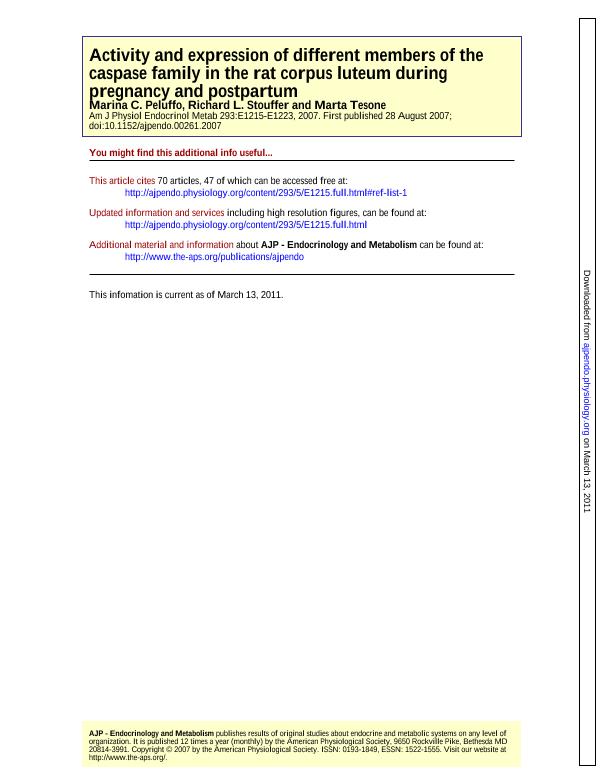Mostrar el registro sencillo del ítem
dc.contributor.author
Peluffo, Marina Cinthia

dc.contributor.author
Stouffer, Richard L.
dc.contributor.author
Tesone, Marta

dc.date.available
2017-10-09T20:59:06Z
dc.date.issued
2007-11
dc.identifier.citation
Peluffo, Marina Cinthia; Stouffer, Richard L.; Tesone, Marta; Activity and expression of different members of the caspase family in the rat corpus luteum during pregnancy and postpartum; American Physiological Society; American Journal Of Physiology-endocrinology And Metabolism; 293; 5; 11-2007; E1215-E1223
dc.identifier.issn
0193-1849
dc.identifier.uri
http://hdl.handle.net/11336/26292
dc.description.abstract
Studies were designed to examine the expression and activity of four caspases that contribute to the initial (caspases-2, -8, and -9) and final (caspase-3) events in apoptosis in the rat corpus luteum (CL) during pregnancy (days 7, 17, 19, and 21 of gestation), postpartum (days 1 and 4), and after injection (0, 8, 16, 24, and 36 h) of the physiological luteolysin PGF2α. In addition, the temporal relationship of caspase expression/activity relative to steroid production and luteal regression was evaluated. During pregnancy, the activity of all four caspases was significantly greater on day 19, before a decline in CL progesterone (P) and CYP11A1 levels at day 21 of gestation. The levels of the caspase-3 active fragment (p17, measured by Western blot) also increased at days 19 and 21 of pregnancy. Immunohistochemical analyses detected specific staining for the caspases in luteal cells (large and small) as well as in endothelial cells. However, the percentage of apoptotic cells did not increase in the CL until postpartum. Following PGF2α injection, there was a significant decrease in CL P by 24 h, although the activity of all four caspases did not increase until 36 h posttreatment. The active p17 fragment of caspase-3 also significantly increased at 36 h post-PGF2α. These results suggest that an increase in the activity of caspases-2, -8, -9, and -3 is associated with the early events of natural luteolysis at the end of pregnancy. Also, the exogenous administration of the luteolysin PGF2α may regulate members of the caspase family.
dc.format
application/pdf
dc.language.iso
eng
dc.publisher
American Physiological Society

dc.rights
info:eu-repo/semantics/openAccess
dc.rights.uri
https://creativecommons.org/licenses/by-nc-sa/2.5/ar/
dc.subject
Caspases
dc.subject
Luteolysis
dc.subject
Corpus Luteum
dc.subject
Pregnancy
dc.subject.classification
Bioquímica y Biología Molecular

dc.subject.classification
Medicina Básica

dc.subject.classification
CIENCIAS MÉDICAS Y DE LA SALUD

dc.title
Activity and expression of different members of the caspase family in the rat corpus luteum during pregnancy and postpartum
dc.type
info:eu-repo/semantics/article
dc.type
info:ar-repo/semantics/artículo
dc.type
info:eu-repo/semantics/publishedVersion
dc.date.updated
2017-10-06T18:02:07Z
dc.identifier.eissn
1522-1555
dc.journal.volume
293
dc.journal.number
5
dc.journal.pagination
E1215-E1223
dc.journal.pais
Estados Unidos

dc.journal.ciudad
Bethesda
dc.description.fil
Fil: Peluffo, Marina Cinthia. Consejo Nacional de Investigaciones Científicas y Técnicas. Instituto de Biología y Medicina Experimental. Fundación de Instituto de Biología y Medicina Experimental. Instituto de Biología y Medicina Experimental; Argentina. Universidad de Buenos Aires. Facultad de Ciencias Exactas y Naturales. Departamento de Química Biológica; Argentina
dc.description.fil
Fil: Stouffer, Richard L.. Consejo Nacional de Investigaciones Científicas y Técnicas. Instituto de Biología y Medicina Experimental. Fundación de Instituto de Biología y Medicina Experimental. Instituto de Biología y Medicina Experimental; Argentina
dc.description.fil
Fil: Tesone, Marta. Consejo Nacional de Investigaciones Científicas y Técnicas. Instituto de Biología y Medicina Experimental. Fundación de Instituto de Biología y Medicina Experimental. Instituto de Biología y Medicina Experimental; Argentina. Universidad de Buenos Aires. Facultad de Ciencias Exactas y Naturales. Departamento de Química Biológica; Argentina
dc.journal.title
American Journal Of Physiology-endocrinology And Metabolism

dc.relation.alternativeid
info:eu-repo/semantics/altIdentifier/url/http://ajpendo.physiology.org/content/293/5/E1215
dc.relation.alternativeid
info:eu-repo/semantics/altIdentifier/doi/http://dx.doi.org/10.1152/ajpendo.00261.2007
dc.relation.alternativeid
info:eu-repo/semantics/altIdentifier/pmid/17726144
Archivos asociados
